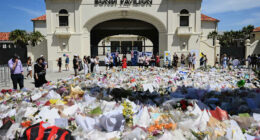Share this @internewscast.com
A nuclear missile is on a collision course with the United States, giving officials less than 20 minutes to avert a catastrophe that could claim 10 million lives.
This chilling scenario forms the backbone of Kathryn Bigelow’s latest film, “A House of Dynamite.”
Acclaimed for its intense realism, the film has sparked discussions about the plausibility of such an event.
Could the most astute military strategists in the United States truly be caught off guard by an unanticipated attack?
Furthermore, would the U.S. President consider retaliatory strikes against potential aggressors before the missile even detonates?
As for the potential failure of America’s missile defense system to intercept and neutralize the threat before it wreaks havoc, how probable is that scenario?
To get the answers to those questions and more, the Daily Mail spoke to a leading nuclear policy expert and examined the revelations in the award-winning book Nuclear War: A Scenario, by bestselling investigative journalist Annie Jacobsen.

A House of Dynamite depicts the terrifying reality of a nuclear attack on the United States. Above: Rebecca Ferguson as Captain Olivia Walker
Could a nuclear launch go undetected, and would officials really not know who fired it?
The film’s central crisis begins early on, with radar at Alaska’s Fort Greely missile base picking up an ICBM heading towards the US mainland.
Initially, officials wearied by previous unannounced, harmless launches by North Korea are not concerned.
But when the missile fails to splash into the Sea of Japan, they realise that this is a real attack.
However, the idea that an enemy missile would not be detected within seconds of launch is very unlikely.
US satellites are known to constantly monitor known launch sites over North Korea and other states.
In the award-winning book Nuclear War: A Scenario, author Annie Jacobsen depicted second by second an attack on the US by North Korea.

Tracy Letts as General Anthony Brady and Gbenga Akinnagbe as Major General Steven Kyle in A House of Dynamite
The book explains that, within half a minute, warning systems within the top secret Cheyenne Mountain Complex in Colorado would have been triggered.
The imagined officials in A House of Dynamite also have no idea who launched the missile and fears are expressed that there could have been a cyber attack.
Darya Dolzikova, an expert in nuclear proliferation and policy at the Royal United Services Institute, said this is the most significant flaw in the plot.
She explained: ‘The biggest suspension of reality that the viewer is being asked to make comes at the very start – namely, that the US, with all its intelligence collection capabilities, is unable to identify who launched the missile.
‘In fact, at one point in the film, Ferguson’s character points to a screen showing the infrared signature of the missile plume; so they clearly have at least some data on the missile which would be helpful to determining the kind of system and – consequently – who it may have belonged to.
‘Which is also what makes the explanation that there could have been a cyber attack difficult to make sense of.
‘If there was a cyber attack, where is the plume imaging coming from?
‘And why is everyone then assuming that this whole thing is not one giant cyber attack and rushing the President into a decision?’
Accuracy rating: 1/5
Would the President, military staff and others really be communicating over a Zoom call?
Not long after the ICBM is detected, a conference call between officials in the US’s various command centres is called.
The President himself later comes on the line, as does the Defence Secretary, who is played by The Crown star Jared Harris.
It is through the medium of the video call that much of the film’s drama plays out.
Given the vast distances separating the various parts of the US military infrastructure, this is what would really happen.
Speaking of what happens in the event of a suspected attack, expert Stephen Schwartz, who has spent years researching the history of America’s nuclear command systems, told US outlet NPR: ‘The National Military Command Center (NMCC) convenes a Threat Assessment Conference Call with multiple lower level duty officers.’
‘If the threat is validated, it becomes a Missile Attack Conference Call joined by more senior officials (and the president, if a senior conferee requests it).’

Not long after the ICBM is detected, a conference call between officials in the US’s various command centres is called
Accuracy: 5/5
Does the US’s interception system really only have a 61 per cent success rate?
One of the most frightening parts of A House of Dynamite sees Deputy National Security Advisor Jake Baerington, played by Gabriel Basso, explaining that the ‘Ground-Based Interceptors’ have a success rate of just 61 per cent.
It prompts the horrified US Defence Secretary to exclaim: ‘A coin toss?! That’s what $50billion buys us?!’
Baerington clarifies to his boss that intercepting an attack is akin to ‘hitting a bullet with a bullet’.
Only two defensive missiles are then fired due to fears that the rest of the stockpile could be needed if further missiles are launched at the US.
Both of the interceptors miss the incoming nuclear warhead, leaving the film’s characters in terrified despair.
Ms Dolzikova is sceptical that US officials would only fire two interceptors.

One of the most frightening parts of A House of Dynamite sees Deputy National Security Advisor Jake Baerington, played by Gabriel Basso, explaining that the ‘Ground-Based Interceptors’ have a success rate of just 61 per cent
She said: ‘It’s hard to believe that, in the face of an incoming ICBM attack, the US would have limited itself to one or even two interceptors or stopped trying to defend against the incoming missile after the first attempt failed.
‘The mid-course phase also seemed to be quite short in the film; there would likely have been more opportunity and time to try intercepting the incoming missile than what was shown.
‘Having said that, it is also highly unlikely that an adversary would fire only a single missile; but I revert to my earlier comment that the plausibility of this becomes harder to judge without any sense of who launched the missile and why.’
The ‘bullet with a bullet’ line in the film comes from a Missile Defence Agency spokesman speaking in 2011.
According to Ms Jacobsen’s book, it is scarily accurate.
‘There is a myth among Americans that the U.S. can easily shoot down an incoming, attacking ICBM,’ she explains.
‘Presidents, congresspeople, defense officials, and countless others in the military-industrial complex have all said as much. This is simply not true.’
She adds that not a single early interceptor test conducted between 2010 and 2013 was successful.
However, a Missile Defence Agency memo obtained by Bloomberg this month gives a far more optimistic view.
The real system, managed by under-fire behemoth Boeing, reportedly gave a 100 per cent success rate in recent tests.
The memo is said to read: ‘The fictional interceptors in the movie miss their target and we understand this is intended to be a compelling part of the drama intended for the entertainment of the audience…’
It goes on to add that results from real-world testing ‘tell a vastly different story’.
Accuracy: 2/5
Would an enemy really target Chicago in a first strike?
The film depicts a list of possible targets for the incoming missile. It then becomes clear that Chicago – one of the cities on the list – is the chosen impact point.
An estimated 10 million people will be killed, viewers learn.
However, given that the centre of the US government is based in Washington DC, along with ordinarily the the President himself when he’s working and in the country, the choice of Chicago for a pre-emptive strike seems unlikely.
Instead, Washington would likely be the primary target.

The film depicts a list of possible targets for the incoming missile. It then becomes clear that Chicago – one of the cities on the list – is the chosen impact point
In her book, Ms Jacobsen explains: ‘Because the Pentagon is a top target for a strike by America’s nuclear-armed enemies, in the scenario that follows, Washington, D.C., gets hit first – with a 1-megaton thermonuclear bomb.’
She quotes Andrew Weber, the former assistant secretary of defense for nuclear, chemical, and biological defense programs.
He revealed that officials most fear a so-called ‘Bolt out of the Blue’ attack.
The term is, he said, how ‘U.S. Nuclear Command and Control refers to an ‘unwanted large [nuclear attack]’.
Accuracy: 2/5
Would an attack on the US really be a total surprise?
The central premise of the film is that the US is attacked without any form of warning or lead-up crisis.
In short, it is the feared ‘Bolt out of the Blue’ as described by Weber.
Fortunately, such a scenario is considered very unlikely in real life.
Ms Dolzikova explained: ‘Generally speaking, a “bolt out of the blue” attack is considered by most to be highly unlikely – though not entirely impossible.
‘A much more likely scenario is an actor resorting to nuclear attack following escalation in a conventional conflict.

The central premise of the film is that the US is attacked without any form of warning or lead-up crisis
‘Such an attack can therefore be expected to follow considerable signalling of an intention to resort to nuclear weapons if the state being signalled to (in this case, I guess, that would have been the US) did not change its behaviour in some way.’
Ms Jacobsen argues in her book that attacking the US out of the blue would be ‘national suicide’.
She writes: ‘All deterrence is predicated on the idea that a Bolt out of the Blue attack against a nuclear-armed superpower all but ensures the attacking nation’s total and complete destruction.
‘Surprise attacks change history. But a surprise attack is designed to decapitate. To cut off the head of the snake.
‘For that, you send the mother lode of weapons; you do not send one, single ICBM.’
Accuracy: 2/5
Is there really such a thing as the ‘Decisions Handbook’?

The film depicts Elba’s President being shown a folder called the ‘Decisions Handbook’. It gives a detailed list of possible targets for a nuclear strike, along with the predicted consequences in terms of casualty numbers and damage
The film depicts Idris Elba’s unnamed President being shown a folder called the ‘Decisions Handbook’.
Military bigwig General Brady, played by Tracy Letts, explains over the conference call: ‘Mr President, significant time and expertise were devoted to designing these options.
‘You’ll find a range, select, limited, and major, depending on the scale of the response you feel is warranted.
Otherwise known as the Black Book, the Decisions Handbook is very much real – although exactly what it looks like is something that only a tiny handful of people will know.
It gives a detailed list of possible targets for a nuclear strike, along with the predicted consequences in terms of casualty numbers and damage.
Ms Jacobsen explains in her book: ‘No one but the most senior-level officials in U.S. Nuclear Command and Control ever sees the contents of the Black Book.
‘The number of people who have written about what they’ve seen is extremely limited: the targets involved, what kind of weapons would be used (kilotonnage versus megatonnage), the mass casualty numbers that will result.’

Otherwise known as the Black Book, the Decisions Handbook is very much real. Above: In the film
Accuracy: 4/5
Is the President really always accompanied by a military official carrying the ‘Nuclear Football?’
The short answer is yes.
In A House of Dynamite, the President’s military aide, Lieutenant Commander Robert Reeves – played by Jonah Hauer-King – is seen accompanying him during a routine engagement.
Then, as the crisis unfolds, Reeves is the man charged with presenting the President with his available options.
After being shown the Black Book, the President has to decide what option to take.
However, whilst Elba’s President appears to be relatively ill-informed about what he has to do, it seems likely that the real commander-in-chief would be more clued up given the stakes involved.
As in the film, the real Black Book is stored within what is known as the ‘Football’.

Photos taken earlier this month showed one of President Trump’s aides carrying the real ‘Nuclear Football’. Above: An aide carrying the satchel onto Marine One as he accompanies President Trump departing Walter Reed Medical Center in Maryland, October 10, 2025
The leather satchel is carried by a military aide who never leaves the President’s side when he is out of the White House.
Photos taken earlier this month showed one of President Trump’s aides carrying the real Football.
Also inside the satchel are what are known as Presidential Emergency Action Documents (PEADs).
These are ready-made executive orders that the President can put into force in an emergency.
Accuracy: 4/5
Would the US really consider preemptively striking every potential hostile nuclear state in the event of an unprovoked attack?
A House of Dynamite depicts officials considering launching preemptive attacks on all of America’s traditional adversaries in the belief that the incoming ICBM could be the start of a coordinated assault on the United States.
When the President insists it is ‘insanity’, General Brady hits back that it is ‘reality’.
However, it is unlikely the decision-making process would play out this way.
General John E. Hyten, the former commander of US Strategic Command (STRATCOM), explained in a 2018 interview with CNN that retaliation would be done in tit-for-tat fashion.
‘If someone launches a nuclear weapon against us we launch one back.
‘They launch another we launch another, they launch two and we launch two. You are on this escalation ladder that ends up nowhere.
‘The key is to stop that behaviour before it gets bad.’
Accuracy: 2/5
Would it just be down to the president to make a decision?

Idris Elba as the US President in A House of Dynamite. He is left having to decide how to respond to the nuclear attack
A House of Dynamite shows the President agonising over how to respond, as the enemy missile is just a few minutes away from hitting Chicago.
It echoes how, in real life, the President would have just minutes to make a decision.
And it is true that such a decision would be the President’s alone, unless he or she were incapacitated.
What’s more, the decision would have to be made in just six minutes, Ms Jacobsen’s book explains.
Former President Ronald Reagan lamented this fact in his memoirs, explaining: ‘Six minutes to decide how to respond to a blip on a radar scope and decide whether to release Armageddon! How could anyone apply reason at a time like that?’
But in her comments to the Daily Mail, Ms Dolzikova did point out that the drama is still a film rather than a documentary.
She said: Overall, I really enjoyed the film. It’s not meant to be a documentary and – broadly speaking – captures well a number of the debates that are central to the nuclear field: Does deterrence work and how do we deter more effectively?
‘What kind and how many capabilities do we need to deter effectively? How do we communicate our intentions to allies and adversaries?
‘How do we threaten an adversary enough to deter them while also managing risks that may arise from miscalculation and miscommunication?’
Accuracy: 5/5
















